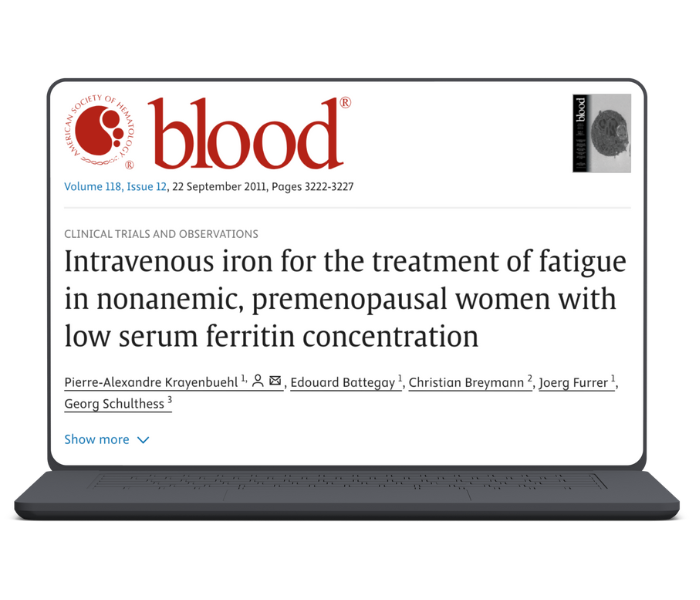FOR DOCTORS
 " />
" />

Dear Doctor,
Below we make the argument that our IDA and NAID patients’ ferritins should be >100 μg/L, to fully rule out any intractable SSx as ascribable to iron, and that IV is the evidence-based, safe & effective, preferred means of achieving that.
Let’s journey together through the evidence for changing the way we diagnose and treat iron deficiency.
We’re advocating for change — here’s the proof.
 " />
" />

SYMPTOMS
Fatigue
Iron-related fatigue improves most significantly when ferritin is raised above 50 μg/L.
Blood Volume 118, Issue 12, 22 September 2011, Pages 3222-3227
Hair Loss
Hair thinning & shedding can begin to occur at ferritin 70 μg/L, much higher than most doctors and patients realize.
Libido
Women with ferritin levels <50 μg/L are less likely to enjoy intercourse, and/or to find their partner desirable, vs. women whose ferritin levels were ≥50 μg/L.
Restless Legs
All people with RLS and a ferritin <75 μg/L should be treated with iron.

DIAGNOSIS













ID guidelines are chaotic and messy.
Over the past decade, 29 guidelines have been published by professional associations worldwide, creating a highly diverse and often confusing array of approaches for the diagnosis and treatment of iron deficiency (ID).
Ferritin thresholds are far too low.
Ferritin is well-recognized as the diagnostic, and most sensitive, marker of uncomplicated iron deficiency — and our thresholds for it are far too low.
Revising Ferritin Lower Limits: It’s Time to Raise the Bar on Iron Deficiency, J Appl Lab Med (2021)
Inflammation masks iron deficiency by falsely elevating ferritin.
Whatever the chosen threshold, a “normal” ferritin does NOT reflexively exclude iron deficiency (ID) because ferritin is profoundly impacted by inflammation. And inflammation is common.
The higher the CRP, the higher the ferritin rises exponentially.
When CRP is <10 mg/L, median ferritin is 77 µg/L. When CRP is 11–80 mg/L, ferritin increases to 173 µg/L; and when CRP is >80 mg/L, ferritin rises further to 445 µg/L — a further exponential increase of 578%.
Ferritin above 100 is normal.
You haven’t fully treated iron deficiency until you reach >100 µg/L ferritin.

IV IRON
Grade A Evidence
Intravenous iron is more effective, better tolerated, and improves quality of life to a greater extent than oral iron supplements (Grade A evidence), in IBD and beyond.
A New Paradigm
“Although oral iron is often viewed as front-line therapy, extensive published evidence has accumulated that IV iron is superior, in both efficacy and safety, to oral iron in many clinical situations and should be introduced much sooner in the treatment paradigm of iron-deficient patients.”
Intravenous Beats Oral
“Intravenous iron offers advantages over oral iron for the treatment of iron deficiency anemia across a wide range of disease states associated with absolute and functional iron deficiency.”
History of IV Iron
IV iron is “impractical, dangerous, and unnecessary as a therapeutic procedure.” Oh wait, that was Goetsch, 1946. You wanna be that guy?
Side Effects Minor & Self-Limiting
“In this multicenter cohort study of 35,737 iron infusions administered to 12,237 patients, the incidence of infusion reactions was 3.9%”
Anaphylaxis: Five in a Million
“Anaphylaxis due to IV iron is exceedingly rare, occurring with <1:200,000 administrations.”
IV Iron Hastens Post-Surg Recovery
IV iron administration (e.g., 500 mg) should be considered if there is less than 4 weeks until surgery.
Expected Lifts to Hemoglobin & Ferritin
The average iron infusion (500-1,000 mg Monoferric) raises ferritin by 100-200 and Hemoglobin by 10-20, as measured 4+ weeks post-infusion.
Am J Hematol (2019)
Mystery Solved: A Typical Case
Persistent, unexplained, non-specific symptoms? Check and correct ferritin to >100 µg/L. It won’t be long before this feels obvious.

IV IRON in Pregnancy
Maternal Outcomes
IV iron not only increases hemoglobin more and at a higher pace than oral iron, but it also reduces maternal complications by 21%.
Impact on Children
Iron deficiency, especially in the first 1,000 days of life, can result in long-lasting, irreversible deficits in cognition, motor function and behaviour.
THE WRAP-UP
We hope the literature presented has made you re-think and question the commonly accepted thresholds of iron deficiency. And further, to see IV as a safe and effective means of achieving a truly asymptomatic ferritin.
Join us in revolutionizing the way that iron-deficient patients are diagnosed and cared for — their health and happiness rests in our capable hands.
SO WHAT'S NEXT?
1) Suspect iron deficiency when you see any of:
- Fatigue
- Insomnia
- Anxiety/depression
- Headaches
- Lightheadedness
- Palpitations
- Loss of libido & decreased enjoyment of sex
- Hair loss or slowed growth
- Cold hands & feet
- Shortness of breath
- Canker sores or mouth sensitivity
- Getting sick (and it lingering) more often
2) Test their ferritin.
- It should be >100 µg/L.
- If complicated by inflammation (i.e., TSAT <0.20 or CRP >5mg/L), ferritin is deceptive and they’re still to be considered iron deficient until TSAT is returned to >0.20.
3) Correct it via IV iron.
- Oral iron doesn’t work all that well. IV should be considered much sooner than it currently is.
- To support with this, you can either refer to any of the 150+ practitioners that we’ve trained (directory coming soon), or send your IDA/NAID patients our way at Gravity Health. Especially if they have extended health (which frequently covers the infusion and/or drug cost).
CONTINUING ED
Where can I learn more?
IronRxCourse.com: Co-created with Dr. Adam Davidson (MD, emergency medicine), this specialized educational program takes HCPs through a no-holds-barred, advanced, up-to-date training in the diagnosis and treatment of iron deficiency through intravenous infusions.
It is currently approved for CE in British Columbia and Ontario, and we are now expanding our sights toward the United States.
Thus far, 150+ HCPs have taken this training, helping to finally end the iron deficiency pandemic we’re needlessly in.
To join the crusade, click below!
Hi, we’re Bobby (Dr. Parmar) and Paul (Dr. Maximus).
We’re on a mission to eradicate iron deficiency via education and IV therapy.























